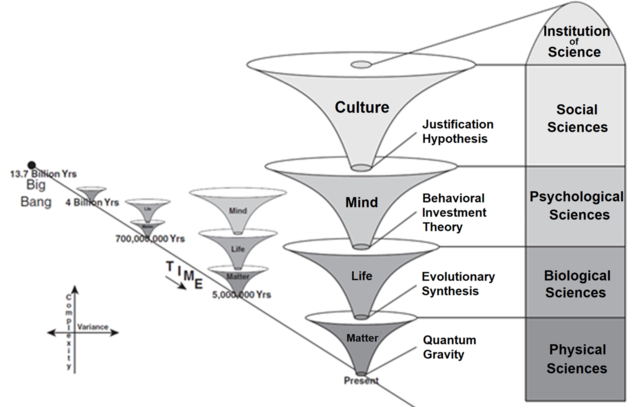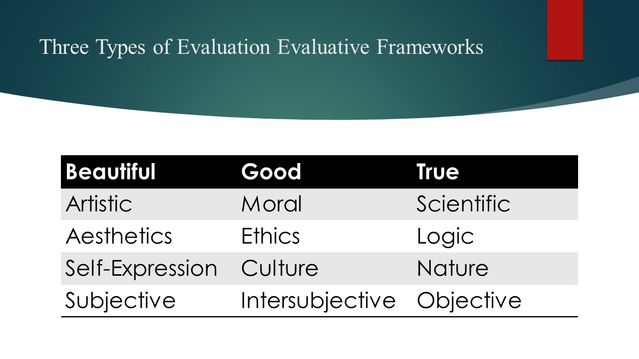Environment
Life’s Big Questions and the Tree of Knowledge
Helping students wrestle with life's big questions via the Tree of Knowledge.
Posted September 11, 2018
This blog was guest authored by Dr. Joseph Michalski.
As an associate dean at the University of Western Ontario, I participated in our first-year student orientation week as a speaker in the college’s PechaKucha Night. The event involves several presentations organized around one of life’s “big questions.” This year’s question was: Do you agree or disagree that humans have the right to modify the natural environment to suit our needs? I wanted to show the value of an enriched understanding that draws from all branches of learning, so I used the Tree of Knowledge System. The success of the talk has prompted me to share a slightly modified version of it here. So as you read this blog, imagine yourself as an incoming student comfortably seated on a gently sloping hill at a university on a cool September evening…
In your journey through college, you will be exposed to many wonderful perspectives on humanity, from literature and the arts to law and business to physics and chemistry. Each of these disciplines helps us understand aspects of who we are and our place in the universe. What I want to do here is to help you approach tonight’s “big question” with an overall view of the whole shebang called the Tree of Knowledge System.

Consistent with modern science, the ToK tells the story of a universe that starts as an energy singularity which erupts via the Big Bang, leading to cosmic inflation. Almost instantly, all the energy that will ever exist was created as the Energy-Matter-Space-Time grid emerged. The first dimension of complexity refers to the emergence of a more purely physical organizational form known as Matter that occurred almost 14 billion years ago. We understand Matter to refer to everything from subatomic particles to the eventual evolution of stars and galaxies. These latter phenomena have been instrumental in helping us understand how the Big Bang set our universe in motion and created the conditions associated with the evolving levels of behavioral complexity.
One key form of Matter is the stars, which in time die violently and release unimaginable amounts of heat and energy. When stars explode as supernova, they forge the elements necessary for the next evolutionary stage. As Carl Sagan put it, perhaps inspired by Joni Mitchell’s lyrics, life is made up of stardust!
Four billion years ago, Matter organized chemically to produce Life on earth, the second dimension of complexity. Cells are the key units of organization in Life. There is a whole invisible world of single-celled life forms that existed on earth for 3 billion years before larger, multi-celled creatures emerged that we call plants.
Shortly after plants, another new kingdom of creatures emerged, which we recognize as animals. Animals sense their surroundings and move with nervous systems. According to the ToK, animals are mental creatures and, as such, the term Mind encompasses the third dimension of behavioral complexity.
Finally, a raft of changes occurred that led to the evolution of hominids and the genus Homo, of which only Homo sapiens survived. That species created Culture with shared symbols, syntactical language, collective memories, and history. Moreover, human beings have developed a remarkable capacity to evaluate information and render judgments.
As humans, we have three main approaches for evaluating the world, dating back at least to the Bhagavad Gita and Plato: the Beautiful, the Good, and the True. While the evaluative schemas can overlap and some people seek integration, the questions we ask typically are aesthetic-artistic, moral-ethical, or scientific-logical in nature.

The PechaKucha question clearly falls into the moral-ethical column, which reflects the nature of “should” or “ought” questions.
There are many nuances to consider in accepting or rejecting the notion that we have the right to modify or perhaps exploit the natural environment for our own purposes. But simply asking such a question tells us a lot about the human species. Rather than attempt to offer a definitive answer to such an important moral question, I strive to explain why people may frame their positions as they do.
The fact we can even ask such a question about human rights reflects 13.8 billion years of cosmic evolution. Other animals communicate, have a form of language, and even use tools. But only humans have developed the more complex, symbolic forms of communication that allow for a shared understanding of our unique place within the natural environment. From a ToK perspective, language and self-consciousness co-evolved to permit intersubjectivity, or a window into the minds of other people.
The ToK comes with a tripartite model of human consciousness, which suggests that we have an experiential self as an animal, a private narrating self that converts experiences into verbal thoughts, and a public self that shares these with others. Yet as we reveal our thoughts, we quickly learn that such openness can create problems. Others may disagree or be displeased with what we reveal for various reasons.

As a result, we must struggle with how we reveal our thoughts, because explaining our thoughts bridges the private to the public. According to this view, our self-consciousness system is a narrating system that functions in part to create narratives that legitimize and justify our actions to others. We are all storytellers and justifiers of one kind or another.
Although people everywhere are storytellers, we do not all share the same language, stories, ethnicity, religion, or worldview. As the differences increase along these dimensions and in other cultural spheres, it becomes harder to understand each other; problems for harmony increase.
As a literal example of cultural distance, consider the issue of language. If we both speak English, then we share a common language and presumably should be able to communicate effectively. If our accents or slang differ significantly, then that may impede our ability somewhat. Or perhaps we speak different dialects altogether, having been born and raised in different countries. But if we don’t speak the same language at all, then the distance is enormous.
On the basis of language and countless other cultural attributes, human beings establish their own groups, cliques, or tribes with unique membership rules and boundaries. We not only distinguish between members and non-members, but, in the extreme, between us and them. We create powerful origin stories and narratives to justify what makes us special and why others not only do not belong, but may be devalued as inferior. Sometimes the “othering” process yields such harsh evaluations that non-group members are dehumanized or not even considered “people.” Under those circumstances, we justify all kinds of mistreatment, subjugation, or even genocide.
If human beings can be located so far from each other in cultural space, what happens if we consider non-human animals? The distance increases. We may anthropomorphize some animals or view them as rather human-like, which may result in more humane treatment or being “adopted” into one’s family as a pet. Yet a sharp divide still remains between human beings and their pets. The idea of having intimate relations with one’s pet, for instance, generates disgust universally. Nor do we typically “eat” our pets, or any animal upon which we have bestowed a formal name.
On the other hand, we kill with impunity a great many sentient animals with “minds,” many of which end up as part of our diets. Indeed, the comparative evidence confirms that the vast majority of people who populate the world’s largest societies consume animals or animal by-products regularly. There can be no question that human beings have long modified and exploited the natural environment for their dietary purposes. What about other life forms?
Once more, cultural distance grows—as does our lack of concern. If ants or cockroaches invade our dwellings, we exterminate them. We spare not a moment’s thought about their well-being. Strict vegetarians and vegans still consume myriad vegetative or plant-based life forms. We modify ecosystems constantly to produce the foodstuffs necessary for our own survival, regardless of how “responsibly” or “sustainably” we accomplish these ends. Yet rarely do people speak of the possible pain and suffering of plants, even though some people argue that trees (as an example) are sentient, conscious entities as well.
And even if we consider those who care for plants, human concerns for living entities in the microscopic world are almost completely absent. With trillions of bacterial and other cells living in our bodies, we are killing microbiota constantly. The cultural distances that separate human beings from bacteria ensure that almost no one spends any waking hours worrying about the well-being of the microscopic world—unless some of that world’s inhabitants pose a threat to our own survival.
Finally, what about other forms of non-living Matter? Do we have the right at least to modify the natural environment to construct our own shelters or to clothe ourselves? Inanimate matter, to be clear, is not even life. Can we at least agree that we should not worry about using nonliving materials to help ensure our own safety and survival? Apart from paleontologists, erosion specialists, and selected others, who would argue that we should worry about rocks? The cultural distance between people and rocks defies any reasonable measurement metric.
Yet while Paul Simon once sang that “a rock feels no pain,” one can certainly approach even rocks and other inanimate matter in a different way. At the very least, rocks do share something in common with human beings: they behave. Everything behaves. (If you doubt this, consider for a moment that physics is the science of the behavior of matter and energy). Everything changes. And everything that exists, by definition, is a part of nature—including us.
Interestingly, although Indigenous peoples typically did not have the scientific knowledge we possess, they understood the deep connections “across the universe” of matter, the earth, other species, and our place among them. Stephen Schwartz captured the philosophy of animism lyrically in the Pocahontas theme song entitled Colors of the Wind: “I know every rock and tree and creature, Has a life, has a spirit, has a name.”
My point here is that a core principle emerges that helps place the question of our “right to modify the natural environment” in a more scientific context: The further removed we are from that understanding of connectedness, the easier it is to modify, exploit, or destroy anything to serve our needs. That principle follows naturally and logically from the universal law of existence. We and every facet of the universe need energy to combat the second law of thermodynamics, or the inexorable march toward entropy.
Whether we are animists or capitalists, we must establish efficient means to harness energy to ensure our own survival. Everything falls apart in time, including us. As human beings, we know that the energy transfers that sustain our bodies will dissipate, our metabolism will cease, and we will die. The cells in our body will revert back to their subatomic state and, at some point in the future, entropy will prevail. The earth itself only has perhaps another five billion years to “live” before being swallowed up by our own sun.
We can return to the PechaKucha once more with a decidedly different understanding of the human condition and our place in the universe: “Do you agree or disagree that humans have the right to modify the natural environment to suit our needs?" And we might add, “…and stave off entropy?” Whether one agrees or not, the fact remains that we are the only species to pose such a question in the first place.
Yet one must remember that H. sapiens are part of the natural environment too, with full membership in the “circle of life.” We presently inhabit the planet Earth and, tethered gravitationally to the sun, we continually rocket around the Milky Way galaxy at more than a half million miles per hour! These are inescapable facts. Whether we have the “right” to modify, manipulate, or exploit the environment, we must acknowledge that we do, we have, and we always will. We cannot survive otherwise.
But, as the justifying animal, we must decide where we fit in the eco-tapestry of life, what we most value, and what practices we believe to be the most sustainable for our lives and for future generations. Unlike every other known species on the planet, we have no choice except to debate our impact. And that may be the most important goal of higher education, or for anyone who hopes to understand life’s big questions. The Tree of Knowledge ideally helps us to look at the familiar in an unfamiliar way and, most important, should facilitate having the debates about life’s big questions as wisely as possible.




